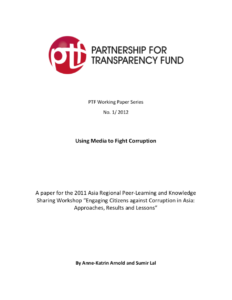WORKING PAPER
Using Media to Fight Corruption
Anne-Katrin Arnold, Sumir Lal
2012
The fight against corruption needs to be fought on several fronts. Institutional reform—legislation and oversight—is one, but it will not be successful if it is not embedded in a broad change of culture. Corrupt practices are often embedded in institutional practices and every-day lives and are perceived as fixed and uncontestable. Citizens are not aware of their rights, are cynical about governments’ propensity to abuse power, fear repercussions, or are simply not aware that corruption is a social, economic, and political problem. The media—traditional mass media as well as new technologies—can play a vital role in unveiling corruption, framing corruption as public problem, suggesting solutions, and generally empower citizens to fight corruption. Media are watchdogs, agenda setters, and gatekeepers that can monitor the quality of governance, frame the discussion about corruption, and lend voice to a wide range of perspectives and arguments. By doing so, media coverage influences norms and cultures, which in turn can influence policy-making and legislative reform. Examples from India and the Philippines, among other places, show that media effects the range from public awareness of corruption to massive protests against the abuse of power. Those in the international community whose work is dedicated to the fight against corruption need to be aware of the power of the media to aid this fight and need to know how to utilize its potential. This paper provides an overview over the basic principles of media effects and illustrates these with a few case studies before presenting specific techniques of involving the media in the fight against grand corruption and every-day corruption.


